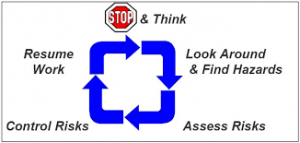Hazard Assessments

Why do we assess hazards?
Working with different industries the understanding of hazard assessments ranges from industry to industry. Heavy industrial companies are usually well versed in the application of hazard assessment, whereas residential or light commercial industries may have heard of the process but do not work on it. Then there are some industries that feel they do not need to assess hazards at all!
I remember coming up through my career and working for companies where we just showed up and went to work. Now was it because there was no risk to what we were doing? Absolutely not, looking back at the situations we put ourselves in I can truly just say we were lucky nothing happened. The companies did not care about anything besides getting the job done and we were just numbers. Then I got into the oil & gas industry and all this paperwork for hazard assessments was dropped on me. I remember thinking I was so smart, I tried to make the perfect photocopy of a prefilled out site-specific assessment, so every day I would just write in the new date. Now looking back at this, it is absolutely ridiculous. For the five minutes, it took to actually assess our job task and write the assessment I spent hours trying to cheat the system. Craziness!
When you break down the hazard assessment process to its core. It is a vital part of a business. Remember if you are a company owner, or supervisor you are responsible to protect the workers under you. If you are a worker for a company you are responsible for your safety and the safety of others around you. If you use these tools properly they will help protect you at every level.

Formal Vs Site-specific
Formal hazard assessments. A formal hazard assessment involves a detailed look at an organization’s overall operations. It’s meant to identify hazards, measure risk (to help prioritize hazards), and develop, implement and monitor related controls. The end goal is to prevent work-related injuries and illnesses. These need to be reviewed with all employees, let the employees have a say and give feedback, and these have to be reviewed at a minimum annually or when the process change.
Site-Specific assessments look at the actual site conditions and type of projects and address only the relevant hazards prior to starting the job or task. In construction and many other industries, conditions change all the time. Tasks change from day to day or hour to hour. It is important to assess the hazards when conditions change and make sure you and your crews are mitigating the hazards and protecting yourselves.
Now the biggest benefit I have found with site-specific hazard assessments. Besides controlling hazards and protecting workers, it is a communication tool. If used properly it can guide you through the tasks to complete, it opens up a channel of communication so everyone is on the same page. The more people involved the more conversation generated, the more hazards are identified, relayed to everyone and mitigated. This is one of the main problems with the get things done mentality, everyone tries to do their own thing and does not communicate properly. When I look back at the days of me trying to photocopy and cheat the system, I was not outsmarting anyone, I was putting myself and my crew at risk for not using the tools we had available properly.
Take the time to assess hazards at all levels. You will start to see improvements in your operations, production will go up, rework and injuries will go down, and morale will improve.
If you need more information there is a plethora of great information on the web from more posts like this, videos, diagrams, and statistics. Or feel free to email and call us, we are happy to help.

